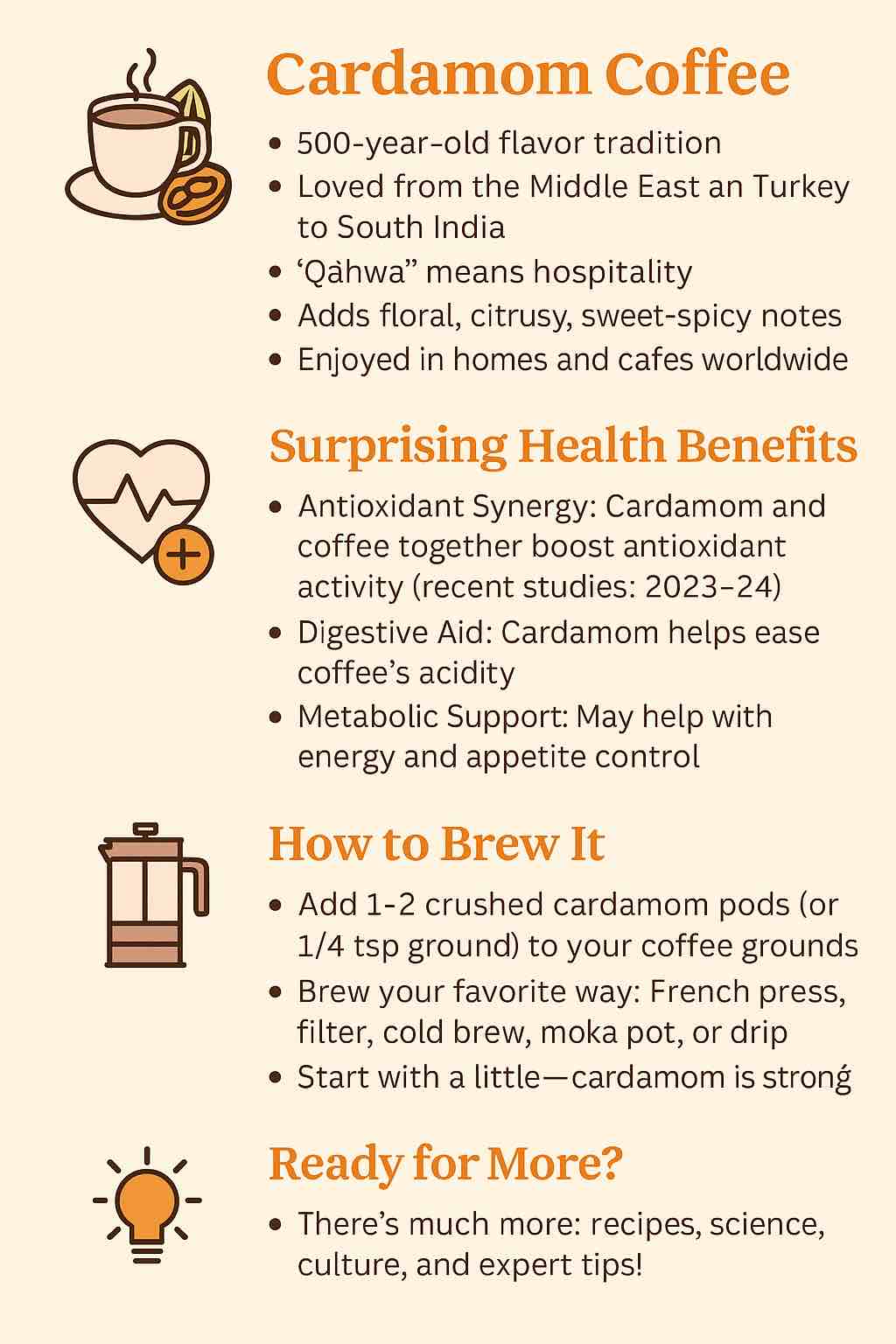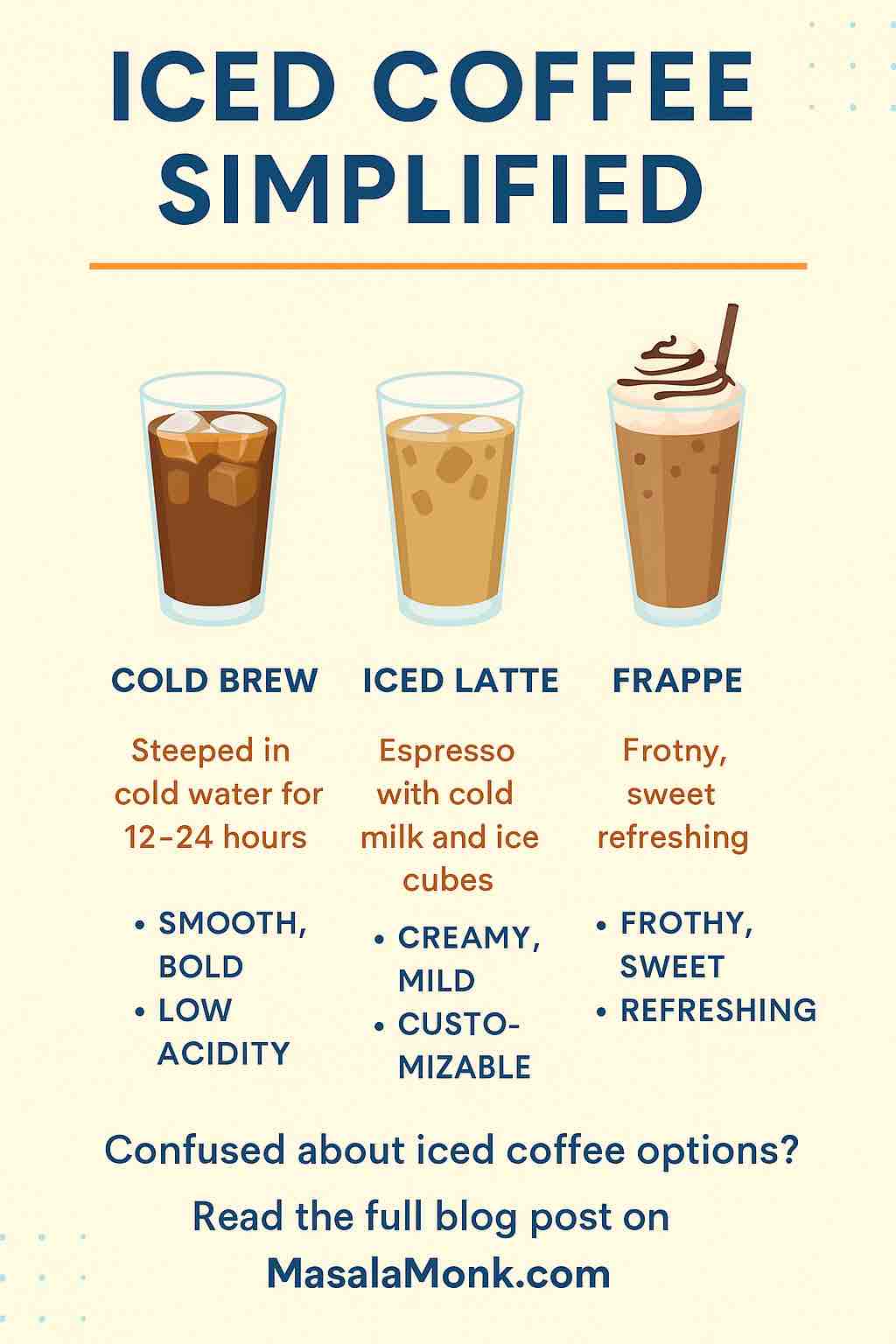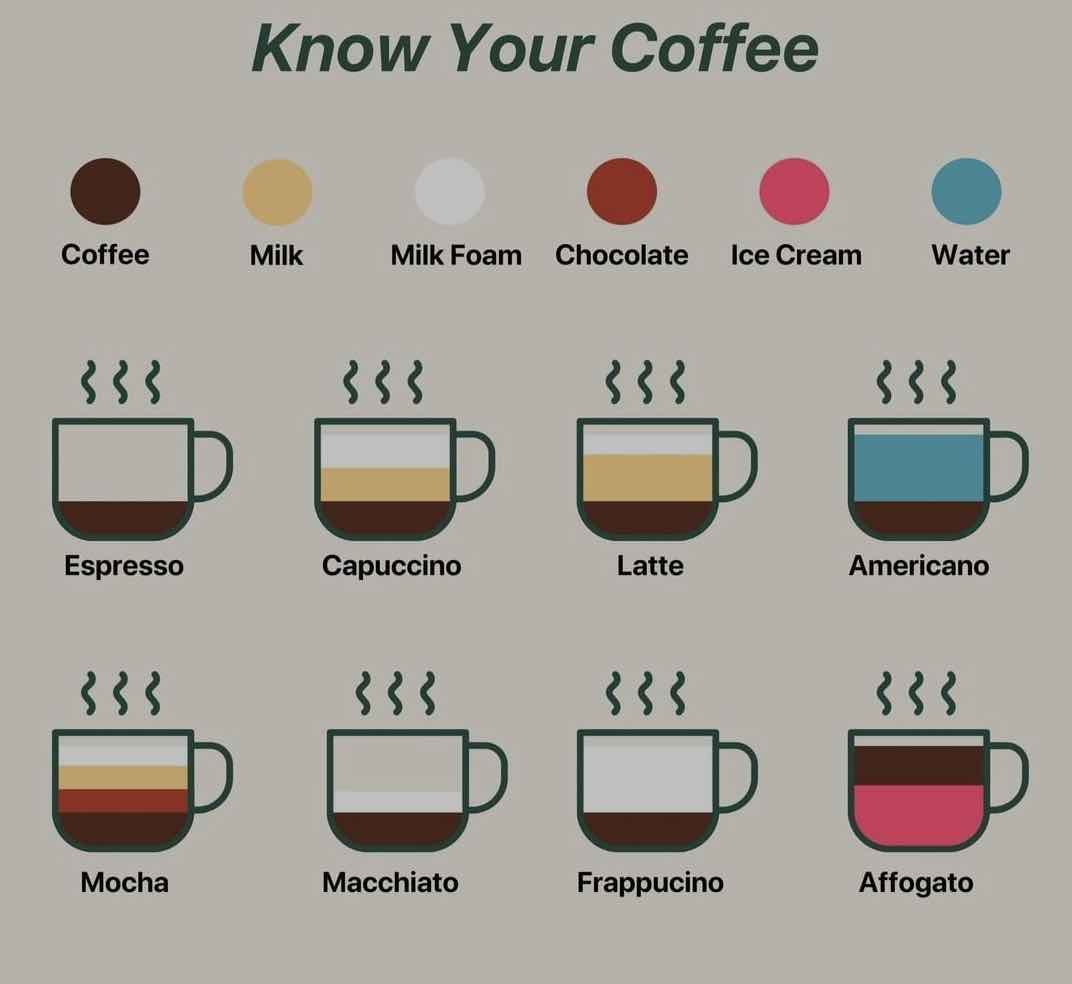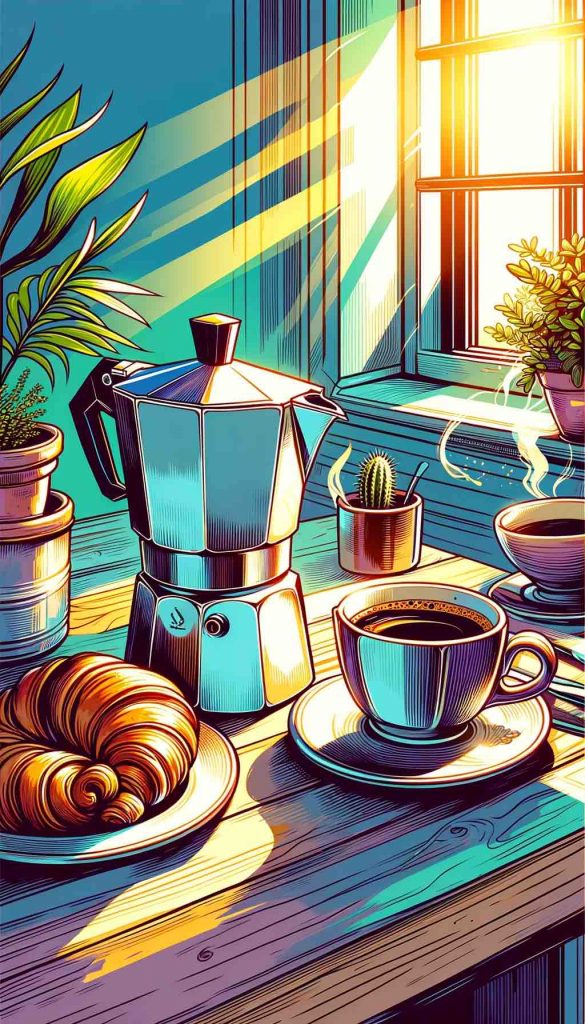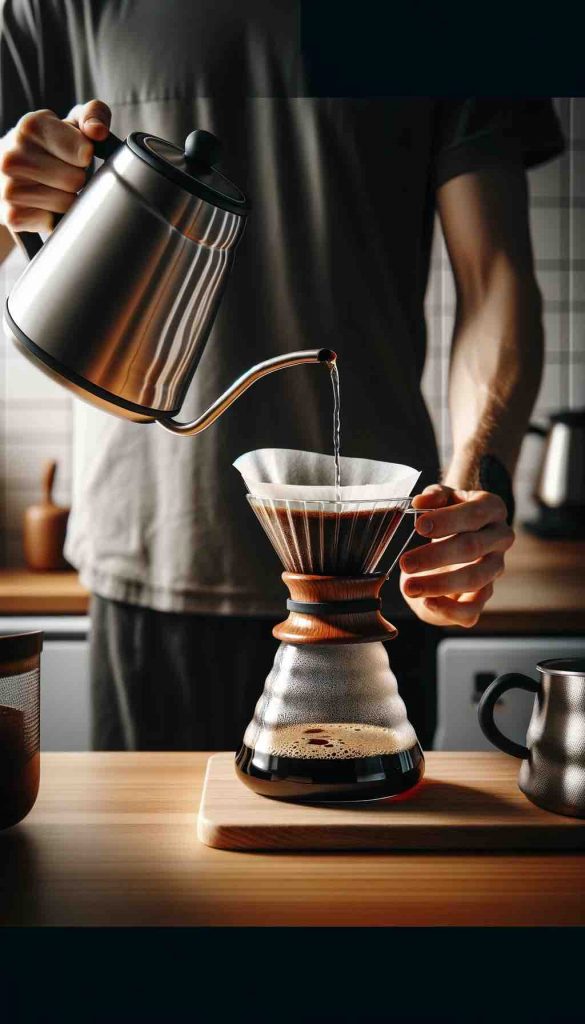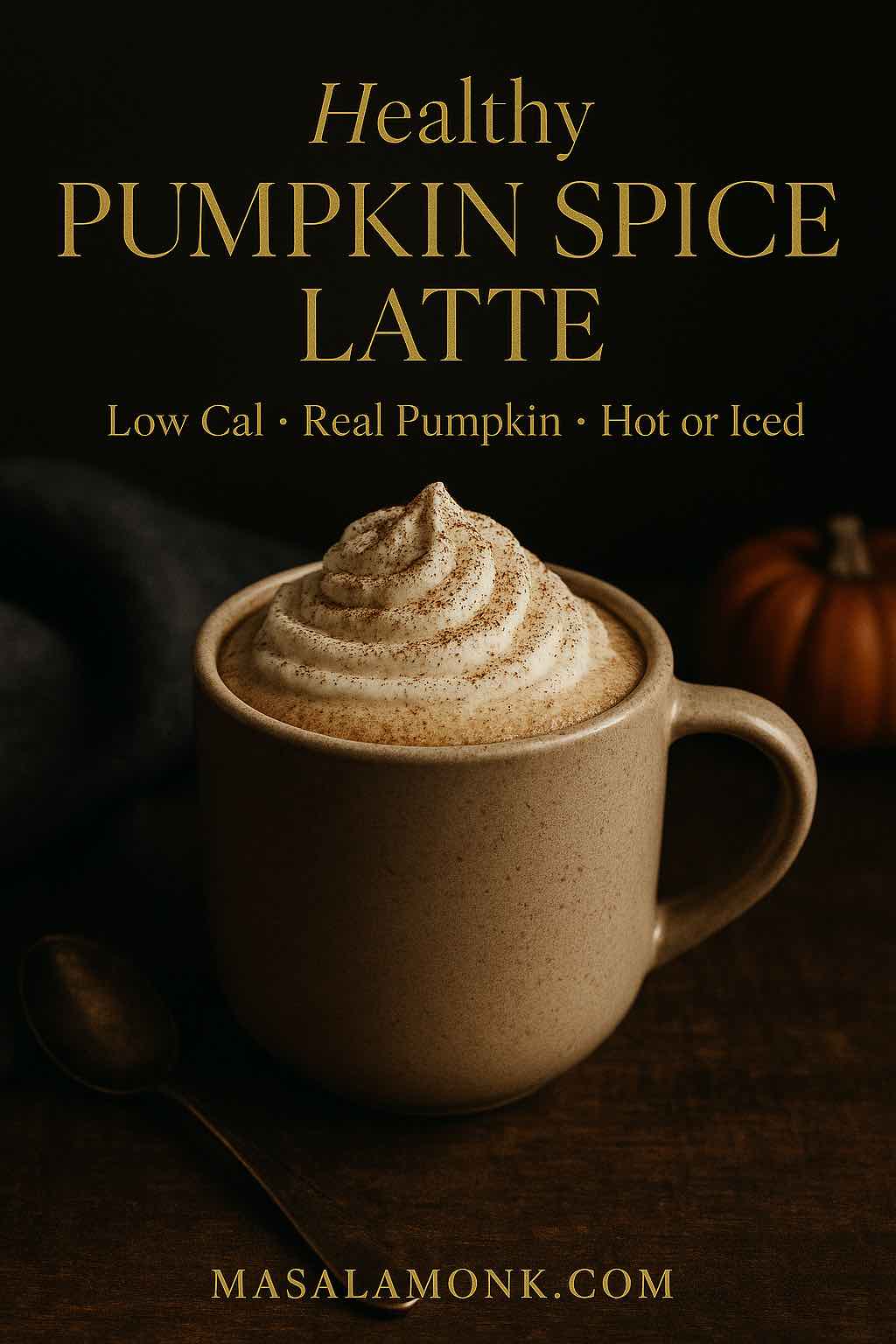
When the air turns crisp and mornings get slower, a Healthy Pumpkin Spice Latte is exactly the kind of cozy you can feel good about. Right from the start, this recipe prioritizes real pumpkin purée, balanced spice, and smart sweeteners, so your Healthy Pumpkin Spice Latte tastes indulgent while staying light. For even better iced results, you might glance at our post on iced coffee methods; understanding cold brew vs. iced espresso vs. shaken lattes instantly upgrades texture.
Why This Version Is a Truly Healthy Pumpkin Spice Latte
To begin with, we build flavor from real pumpkin and a precise spice blend (cinnamon, ginger, nutmeg, clove) rather than relying on multiple pumps of syrup. As a result, your Healthy Pumpkin Spice Latte delivers warmth, body, and aroma without a sugar crash. Additionally, you can steer calories by milk choice—unsweetened almond for the leanest profile, skim for dairy protein without fat, or oat for extra creaminess. For context and honest comparisons, the official café baselines are here: Starbucks hot PSL nutrition and Starbucks iced PSL nutrition (starbucks.com). You’ll see how quickly sugar and calories climb with standard builds.
Moreover, using real pumpkin gives you a little fiber and micronutrients with very modest sugars. If you like specifics, skim the canned pumpkin nutrition profile (MyFoodData, USDA-based). Put simply: the Healthy Pumpkin Spice Latte approach leans on whole ingredients and method control, not just “less syrup.”
Ingredients for a Healthy Pumpkin Spice Latte (1 Serving, ~12 oz / 355 ml)
Before we begin, gather everything in one place; preparation makes the pour seamless. Then, follow the lists below—organized so you can choose quickly without second-guessing. Choose one milk and one sweetener; the rest stays the same.
Core base (must-have)
- Espresso: 30–60 ml (1–2 shots) or ~90 ml strong brewed coffee
Tip: Start with 1 shot for balance; add a second if you prefer a bolder Healthy Pumpkin Spice Latte. - Pumpkin purée: 30 g (2 Tbsp), 100% pumpkin (not pie filling)
- Vanilla extract: ½ tsp
- Fine salt: a small pinch (it rounds sweetness and spice)
Milk (pick one)
- Unsweetened almond milk — 200 ml (¾ cup + 1 Tbsp): ultra-light and lowest in calories.
- Skim milk — 200 ml: lean dairy with extra protein and a clean latte finish.
- Unsweetened oat milk — 200 ml: naturally creamy; slightly higher calories but luxurious texture.
Preferably, choose cold milk for iced versions; otherwise, any works.
To get precise control of ingredients, additives, macros and quality of your milk we have couple of posts that explain How to make Almond Milk at Home and then Easy Homemade Oats Milk with just One Ingredient- Non Slimy, at last.
Pumpkin spice blend (balanced & bright)
Use 1 tsp total, mixed as:
- ⅝ tsp ground cinnamon
- ⅛ tsp ground ginger
- ⅛ tsp ground nutmeg
- A tiny pinch clove (go easy—clove dominates quickly)
For a precise recipe and some of the variants you can make at home, read our post on Pumpkin Spice, Your Way: Master Blend, Variations & Real-World Recipes. Alternatively, use 1 tsp of a quality pre-mixed pumpkin pie spice.
Sweetener (to taste—choose one)
- Zero-calorie: liquid stevia, monk-fruit drops, or erythritol/monk-fruit blend (start light; add gradually).
- Natural: 1–2 tsp maple syrup or honey for classic café sweetness.
- Low-glycemic twist (optional): 1–2 tsp allulose for clean sweetness without a cooling aftertaste.
Because pumpkin softens bitterness, you’ll often need less sweetener than you expect.
For iced Healthy Pumpkin Spice Latte
- Ice: ~200 g (heaping cup), plus extra for the glass
- Optional cold foam: 60 ml milk (of your choice), frothed separately
Flavor extras (optional, but lovely)
- Citrus spark: the faintest whisper of orange zest (⅛ tsp) brightens the spices.
- Caramel note: ¼ tsp molasses introduces depth without much sugar.
- Saffron warmth: a few strands steeped in a splash of your milk add aromatic complexity.
Equipment (simple is fine)
- Whisk or handheld frother (for hot microfoam)
- Shaker or jar with lid (for the iced, frothy finish)
- Small saucepan (if making the hot version)
Quick metric/US snapshot
- Espresso 30–60 ml = 1–2 shots
- Milk 200 ml = ~¾ cup + 1 Tbsp
- Pumpkin purée 30 g = 2 Tbsp
- Spice blend = 1 tsp total
Finally, to keep your Healthy Pumpkin Spice Latte consistent day after day, pre-mix a small jar of the spice blend and store it airtight; subsequently, each cup becomes a simple “scoop and whisk.” Do not miss our full post on how to make how to make pumpkin pie spice blend, and its variants.
Method: Hot Healthy Pumpkin Spice Latte (≈10 Minutes)
First, warm the base: in a small saucepan over medium-low, whisk milk, pumpkin purée, spice blend, vanilla, sweetener, and a pinch of salt for 3–4 minutes until steaming—avoid a rolling boil to preserve aroma. Next, froth to a latte-like texture using a whisk, handheld frother, or (carefully) a heat-safe jar. Meanwhile, pull 1–2 shots of espresso into a mug (or pour in hot strong coffee). Finally, combine by topping the coffee with your pumpkin milk. Taste; adjust sweetness or spice. Because pumpkin adds body and softens bitterness, you may need less sweetener than expected—another reason this is a Healthy Pumpkin Spice Latte you’ll actually crave daily.
Method: Iced Healthy Pumpkin Spice Latte (Shaker Method)
First, brew and cool: pull espresso and let it stand 1–2 minutes, or use a cold espresso concentrate. Then, shake: in a cocktail shaker or jar, combine espresso, cold milk, pumpkin purée, spice, vanilla, sweetener, and ice; shake 10–15 seconds until chilled and lightly frothy. Afterward, strain over fresh ice to avoid extra dilution. For a café-style finish, top with cold foam; see How to Make Cold Foam (Better Homes & Gardens) and a clever, low-cost option in Why I Love the French Press (Serious Eats). As a result, your iced Healthy Pumpkin Spice Latte will have the silky cap you love—no special machine needed. And if you want to go deeper on cold methods, circle back to our post on iced coffee methods.
Quick Recipe Card for Healthy Pumpkin Spice Latte (Hot or Iced)
Yield: 1 serving · Time: 10 minutes (hot) / 5 minutes (iced)
Ingredients
- 30–60 ml espresso (1–2 shots) or ~90 ml strong coffee
- 30 g (2 Tbsp) pumpkin purée (100% pumpkin)
- 1 tsp pumpkin spice blend (see notes)
- 1/2 tsp vanilla extract
- Pinch fine salt
- 200 ml milk of choice (almond/skim/oat)
- Sweetener to taste (zero‑cal or 1–2 tsp maple/honey)
- For iced: ~200 g ice, plus more for glass; optional 60 ml cold‑foam milk
Instructions (Hot)
- In a small saucepan over medium‑low, whisk milk, pumpkin, spice, vanilla, sweetener, and salt 3–4 min until steaming. Do not boil.
- Froth to microfoam.
- Brew espresso into a mug.
- Pour spiced milk over espresso; taste and adjust.
Instructions (Iced, Shaken)
- Pull espresso; let stand 1–2 min (or use cold concentrate).
- In a shaker, combine espresso, cold milk, pumpkin, spice, vanilla, sweetener, and ice. Shake 10–15 sec.
- Strain over fresh ice; top with cold foam if desired.
Notes
- Spice mix: 5/8 tsp cinnamon, 1/8 tsp ginger, 1/8 tsp nutmeg, tiny pinch clove.
- Flavor extras: 1/8 tsp orange zest; 1/4 tsp molasses; a few saffron strands (steeped).
- Grande (~16 oz): scale by 1.3–1.4×.
Estimated nutrition (almond milk base): ~90 kcal; ~10 g carbs; ~4 g sugar; ~3 g fat; ~2 g protein.
Macros, Comparisons, and Sensible Tweaks for a Healthy Pumpkin Spice Latte
Because milk choice drives most of the calories, start there. Per ~12 oz serving (with 30 g pumpkin purée and zero-cal sweetener), expect roughly:
- Unsweetened almond milk: ~90 kcal, ~10 g carbs, ~4 g sugar, ~3 g fat, ~2 g protein
- Skim milk: ~135 kcal, ~21 g carbs, ~14 g sugar, ~0 g fat, ~9 g protein
- Unsweetened oat milk: ~170 kcal, ~22 g carbs, ~7 g sugar, ~6 g fat, ~3 g protein
If you add 2 tsp maple syrup, plan for about +34 kcal and +~9 g sugar. Even so, maple is assertive, so a small amount provides plenty of flavor. Meanwhile, remember that pumpkin purée adds a little fiber and body with modest sugars; for numbers, keep this canned pumpkin nutrition page (MyFoodData) handy.
For perspective, compare your Healthy Pumpkin Spice Latte to Starbucks hot PSL nutrition or Starbucks iced PSL nutrition (starbucks.com). On balance, the homemade cup stays lean because you control milk and sweetener instead of defaulting to multiple syrup pumps.
Variations That Keep Your Healthy Pumpkin Spice Latte Fresh
Keto / Low-Carb Healthy Pumpkin Spice Latte: Choose unsweetened almond milk and a zero-cal sweetener. If you also track caffeine, try one espresso shot and adjust later. For a cozy non-coffee day, our vegan keto smoothie kick-start echoes fall spice while staying low in sugar.
Vegan Healthy Pumpkin Spice Latte: Pick almond or oat milk and sweeten with monk fruit or maple. Oat brings café-style creaminess; almond keeps calories lean. Either way, the pumpkin + spice profile remains the star.
No-Coffee / Decaf Healthy Pumpkin Spice Latte: Swap espresso for strong chai or rooibos, or simply use steamed milk. Brew a small tea concentrate and treat it like espresso in the method; the spices harmonize beautifully.
Troubleshooting and Pro Tips for Your Healthy Pumpkin Spice Latte
- Spice settling: Before heating, whisk the spice into the pumpkin purée; the purée helps suspend fine particles so they don’t sink.
- Too thin: Add 1–2 tsp more pumpkin purée or reduce milk by 20–30 ml to concentrate texture.
- Not pumpkiny enough: Increase purée to 40 g and add ¼ tsp more cinnamon; if the flavor turns “muddy,” reduce clove first—it’s potent.
- No frother, no problem: A French press makes quick microfoam; see this French press overview (Serious Eats).
- Iced texture matters: Shake vigorously to produce tiny bubbles and a creamier sensation, even with almond milk. Additionally, always strain over fresh ice.
- Batching for guests: Prepare a larger batch of the spiced milk base and keep it warm. For safety, stay out of the “danger zone.” Review USDA slow-cooker tips (usda.gov) and the simple keep-hot guideline ≥ 140°F / 60°C (FoodSafety.gov). Then add espresso to each mug just before serving so the coffee stays vibrant.
How to Slot a Healthy Pumpkin Spice Latte Into Your Week
Realistically, most of us want easy repetition. Consequently, try this cadence:
- Weekdays: Unsweetened almond milk + zero-cal sweetener; make the hot version in the morning and the iced version in the afternoon.
- Weekends: Switch to oat milk, add a small splash of maple, and treat it like dessert—no apology needed.
- Meal prep: Mix a three-day base (milk + pumpkin + spice + vanilla + sweetener) and refrigerate. Before each cup, re-shake or whisk, then add espresso and heat or shake over ice. In practice, this keeps your Healthy Pumpkin Spice Latte consistent without fuss.
By the way, when you want a thicker, post-workout option that still hits fall notes, peek at our pumpkin seed smoothie ideas. It’s not a latte, certainly, but it’s seasonally aligned and satisfying.
Why This Healthy Pumpkin Spice Latte Keeps Working
At any rate, the magic is simple: whole ingredients and deliberate technique. Because you aren’t locked into fixed syrup pumps, you can adjust sweetness in tiny steps. Because you froth (or shake) properly, you can dial creaminess regardless of milk. And because you use pumpkin purée, you add body and color without runaway sugar. In short, the Healthy Pumpkin Spice Latte respects flavor and goals.
Meanwhile, it’s flexible. Prefer perfumey spice? Increase cinnamon and nutmeg while easing clove. Want more body without extra calories? Froth a small portion of milk into cold foam and spoon it on top. Need stronger coffee presence? Use two shots, then balance with 1–2 extra teaspoons of pumpkin. Finally, if you want to fine-tune the iced path, revisit our post on iced coffee methods. And keep these two official references nearby for honest comparisons as you tweak: Starbucks hot PSL nutrition and Starbucks iced PSL nutrition (starbucks.com).
FAQs
1) What exactly makes this a Healthy Pumpkin Spice Latte?
Because we build flavor from real pumpkin purée and a balanced spice blend—rather than multiple syrup pumps—you get body, aroma, and warmth with fewer added sugars. Additionally, you control milk and sweetener, so calories and carbs stay in check.
2) How many calories are in one serving of Pumpkin Spice Latte?
Typically, 12 oz lands around ~90 kcal with unsweetened almond milk, ~135 kcal with skim, and ~170 kcal with unsweetened oat. Of course, add 30–40 kcal if you stir in 2 teaspoons of maple syrup.
3) Can I make a Healthy Pumpkin Spice Latte without coffee?
Absolutely. Instead of espresso, use strong chai or rooibos, or simply steamed milk. Consequently, you keep the cozy pumpkin-spice profile while skipping caffeine.
4) How do I make a vegan Pumpkin Spice Latte?
Simply choose almond or oat milk and a plant-based sweetener (e.g., monk fruit or maple). As a result, the texture remains creamy while the drink stays dairy-free.
5) How do I keep my Pumpkin Spice Latte keto / low-carb?
First, select unsweetened almond milk. Then, sweeten with a zero-calorie option like stevia or a monk-fruit blend. Therefore, you’ll reduce net carbs while keeping flavor intact.
6) Does this recipe of Pumpkin Spice Latte use real pumpkin?
Yes—each serving uses about 30 g (2 Tbsp) of 100% pumpkin purée. Accordingly, you get a touch of fiber and body with modest sugars, unlike syrups alone.
7) Can I make an iced Healthy Pumpkin Spice Latte that still tastes rich?
Definitely. Shake the drink with ice for 10–15 seconds; that agitation adds tiny bubbles and creaminess. Then, for café-style texture, crown it with a small spoonful of cold foam.
8) What’s the best milk for a Healthy Pumpkin Spice Latte?
It depends. Unsweetened almond milk is leanest, skim milk adds protein with minimal fat, and oat milk yields the lushest mouthfeel. In short, pick based on goals: calories, protein, or creaminess.
9) How can I cut sugar but keep flavor in Pumpkin Spice Latte?
Start with zero-calorie sweeteners and rely on pumpkin + spice for depth. Moreover, a small pinch of salt and a splash of vanilla round perception of sweetness so you can use less.
10) How do I prevent spices from sinking to the bottom of Pumpkin Spice Latte?
Before heating, whisk the spice directly into the pumpkin purée; the purée suspends fine particles. Likewise, give the finished drink a quick swirl before the final sip.
11) Can I batch this for guests or meal prep?
Yes. Prepare the spiced milk base (milk, pumpkin, spice, vanilla, sweetener) and keep it warm for serving or chill up to 3 days. Afterwards, add espresso to each cup to keep the coffee vibrant.
12) Is there a slow-cooker version of Healthy Pumpkin Spice Latte?
Certainly. For gatherings, warm the spiced milk base on Low, then hold on Warm. Subsequently, pour espresso into each mug and top with the hot base. Stir before each pour so spices stay even.
13) What’s the right espresso dose—one shot or two?
Begin with one shot for balance. Then, if you prefer stronger coffee notes, add a second shot and, if needed, slightly increase pumpkin purée (by 1–2 tsp) to keep harmony.
14) Can I make a grande-size Healthy Pumpkin Spice Latte?
Yes—scale ingredients by 1.3–1.4× for ~16 oz. Nevertheless, taste as you go and adjust sweetness gradually; it’s easier to add than to dial back.
15) How do I get thicker body of Pumpkin Spice Latte without extra calories?
First, froth a small portion of your milk to create microfoam; next, spoon it on top. Additionally, bump pumpkin purée by 1–2 teaspoons for natural viscosity.
16) What if I want a pumpkin spice chai instead of a coffee latte?
Simply swap the espresso for strong chai concentrate. Consequently, you’ll get a spiced, tea-forward variation that pairs beautifully with pumpkin and vanilla.
17) Which sweetener tastes closest to café sweetness?
For most palates, a monk-fruit/erythritol blend reads clean. Alternatively, 1–2 teaspoons of maple syrup deliver classic café character—just budget the added calories.
18) How should I store leftovers?
Cool the spiced milk base quickly and refrigerate in an airtight jar for up to 3 days. Then, shake before using and add fresh espresso when serving hot or iced.
19) Can I use pumpkin pie spice instead of a custom blend?
Yes. Use 1 teaspoon of a quality pumpkin pie spice. However, if clove dominates, reduce the total to ¾ teaspoon and compensate with a pinch of extra cinnamon.
20) Any tips for a copycat café feel at home?
Indeed. Froth milk (or make cold foam), strain iced drinks over fresh ice, and dust the top lightly with cinnamon. Furthermore, serve in a pre-warmed mug (hot) or a chilled glass (iced) for a professional finish.


